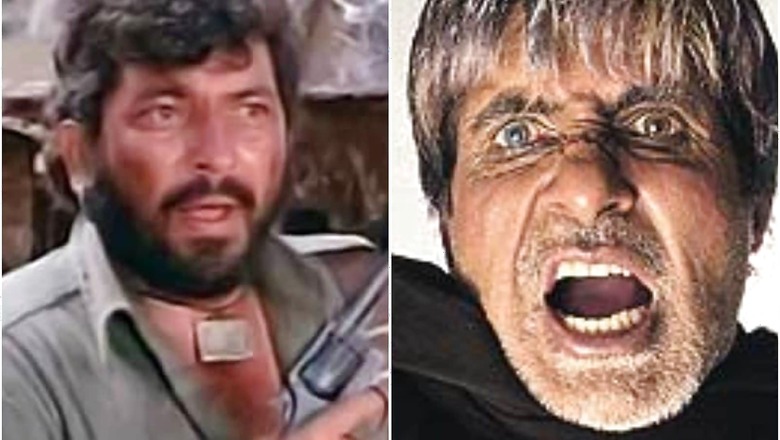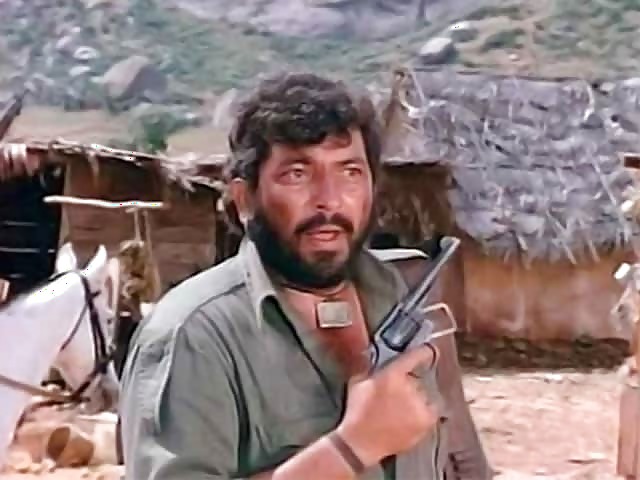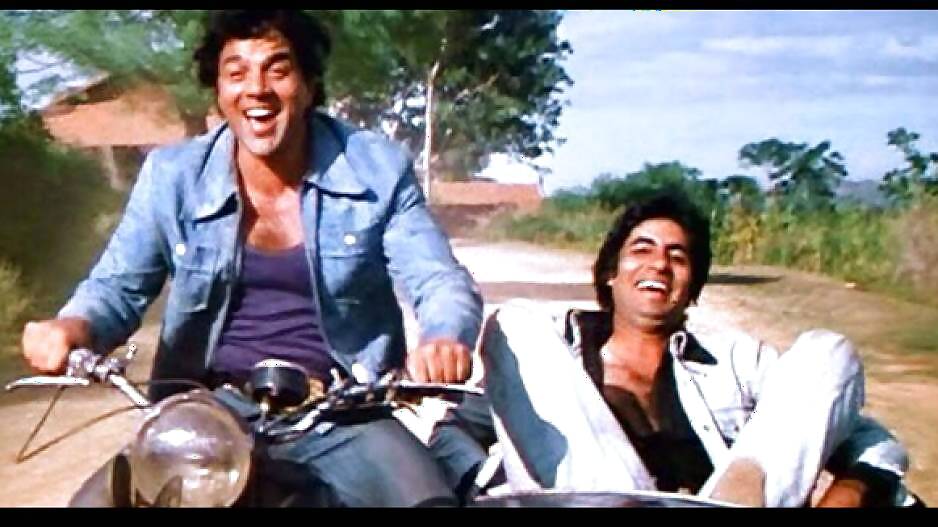
views
In this weekly column, Reel Retake, we compare the original film and its remake. Beyond highlighting the similarities, differences and measuring them on the success scale, we aim to discover the potential in the storyline that spurred the thought for a newer version and the ways in which a remake could possibly offer a different viewing experience. And if that is the case, analyse the film.
In focus this week is action drama Sholay (1975) and its remake/tribute Ram Gopal Verma Ki Aag, which was released in 2007.
What’s Sholay about?
Gabbar Singh (Amjad Khan), a dreaded dacoit wanted by the authorities, kills almost all the family members of former police inspector Thakur Baldev Singh (Sanjeev Kumar) and cuts off both his arms. Now Gabbar’s terror reigns unrestrained in the village of Ramgarh while Thakur lives for revenge. He hires two small-time thieves, Jai (Amitabh Bachchan) and Veeru (Dharmendra), and promises them a handsome reward if they surrender Gabbar to him alive.
Veeru and Jai grow close to the villagers. Veeru is attracted to Basanti (Hema Malini), a talkative young woman who makes her living by driving a horse-cart. Jai starts to like Thakur’s widowed daughter-in-law Radha (Jaya Bachchan).
Meanwhile, the fight between Gabbar’s gang and Jai and Veeru intensifies when Gabbar murders the local imam’s son to coerce the villagers into surrendering Veeru and Jai. The villagers refuse and instead get the duo to kill four of Gabbar’s men in revenge for the boy’s death. Gabbar retaliates by having his men capture Veeru and Basanti.
Jai arrives to the rescue by attacking the gang, and the three are able to flee Gabbar’s hideout with dacoits in pursuit. Fighting from behind a rock, Jai and Veeru nearly run out of ammunition. Veeru, unaware that Jai was wounded in the gunfight, is forced to leave for more ammunition and also to drop Basanti at a safe place. Jai eventually sacrifices himself by using his last bullet to ignite dynamite sticks on a bridge from close range, killing several of Gabbar’s men.
Enraged over his friend’s death, Veeru attacks Gabbar’s den, kills his remaining men and catches Gabbar. Veeru nearly beats Gabbar to death until Thakur appears and reminds him that he wanted Gabbar alive. Thakur uses his shoes to severely injure Gabbar. Police arrive to arrest Gabbar for his crimes. After Jai’s funeral, Radha is left alone again. Veeru leaves Ramgarh and finds Basanti waiting for him on the train.
Wherein lies the potential?
Sholay skillfully blends revenge and Hollywood’s Western genre and tempers it with humour, action and melodrama to deliver an out-and-out entertainer. Set in the village of Ramgarh, the scorching heat and humidity of the surroundings are weighing down heavily on the natives and also reflect the simmering rage of Thakur and his desire for revenge.
Jai and Veeru are two sides of the same coin, as is reflected in them using it again and again to make important decisions in life. They are driven by greed but have a change of heart upon learning the injustice done by Gabbar and his dacoits. All the characters are bold and that has made Sholay one of the most celebrated movies in the Indian cinema. A major reason for its success are the dialogues. They have become a part of our lingo. It is also one of the most replayed movies on TV and has been watched across generations. Amjad particularly gained popularity after his wickedly-crafted villainous role as Gabbar. Viewers like to revel in the sheer audacity of Gabbar and the headstrong Thakur, who is consumed by revenge. Keeping in mind the technology of the time, Sholay is very well directed. It is also packaged well with a fitting background score and commendable cinematography, especially the wide angle shots that quickly remind one of Westerns. Its action sequences are not over-the-top and helps in keeping things realistic on screen.

Music maestro RD Burman was behind the movie’s background score. His songs Mehbooba and Holi ke din are listened to till date. Yeh dosti is a timeless track and a fitting ode to friendship. Sholay incorporates many themes and continuously changes tone but never looks jarring. For instance, it has two of the most wacky characters Soorma Bhopali (Jagdeep) and Jailer (Asrani) seen on screen, who lend a comical detour. For a brief period, the film then suggests that even though the characters are motivated and are self-indulgent to a fault, entertainment does not need to be sacrificed. Veeru, in the midst of all the action, finds time to profess his love for Basanti from the top of a water tank, getting drunk during the day. Sholay also dwells intensely upon the friendship theme and through Big B and Dharmendra’s chemistry, the template of ideal bond on screen is created.

What Ram Gopal Verma Ki Aag does terribly wrong
Ram Gopal Verma adapts the Sholay storyline but shifts base to the city. Aag has great style because of the director’s vision of exploring newer facets in storytelling. It’s cinematography in set pieces like when Narsimha (Mohanlal) interrogates Hero (Ajay Devgn) and Raj (Prashant Raj) and buys their loyalty is not only innovative in making good use of contrast lighting but also has a fast editing technique and constantly gliding camera reflecting the state of his characters’ mind. But while Verma succeeds in making set pieces work, the overall film does not leave an impact. The whole experience turns out to be a little underwhelming. The chemistry of lead actors Ajay and Prashant is also off in more than one way and doesn’t reflect the sincerity and affection of Big B and Dharmendra’s Jai and Veeru. A major theme of Sholay is compromised right there.
Furthermore, the look, motivations and interpretation of each character is drastically changed. Emotions then seem disjointed and relatability with the character is compromised. Babbban (Amitabh Bachchan) does least justice to the negative character. He is made out to be caricature-like and does not inspire fear. The stylised and modern version of Gabbar never went down well with the audience. For a character working in the late 2000s, Babban looks stuck in the past, all while appearing contemporary in his look.
Priyanka Kothari as Ghungroo has imbibed the city-dwelling, rebel girl well but the innocence that Basanti exuded is not in her. Instead, she fights anyone who tries to outsmart her and at times feels too loud. None of the characters are fleshed out and their motivations are unclear. There are hardly any scenes with more than two people in the frame together. There are mostly shoulder shots and close-ups. This gives very little room for the chemistry to reach the audience.
Success meter
Sholay has acquired a cult status in Hindi cinema over the years. The darkness in the characters came forth even when shot during broad daylight, mostly, because of the screen presence of the actors and their unforgettable dialogues. Ram Gopal Verma Ki Aag is mostly shot in less light but still does not inspire any terror. At the box office too, Aag was a major disappointment and suffered a huge loss. On IMDb, it is one of the worst rated Hindi films and highly disliked by purists.
Read all minute-by-minute news updates for Uttar Pradesh election results 2022, Punjab election results 2022, Uttarakhand election results 2022, Manipur election results 2022, and Goa election results 2022.
Click here for seat-wise LIVE result updates.




















Comments
0 comment